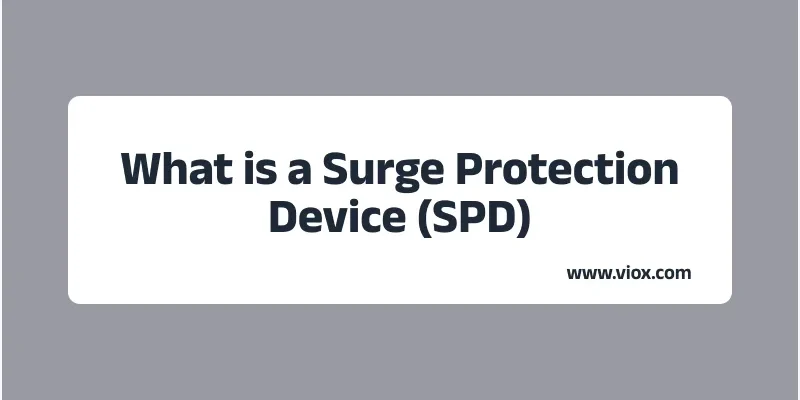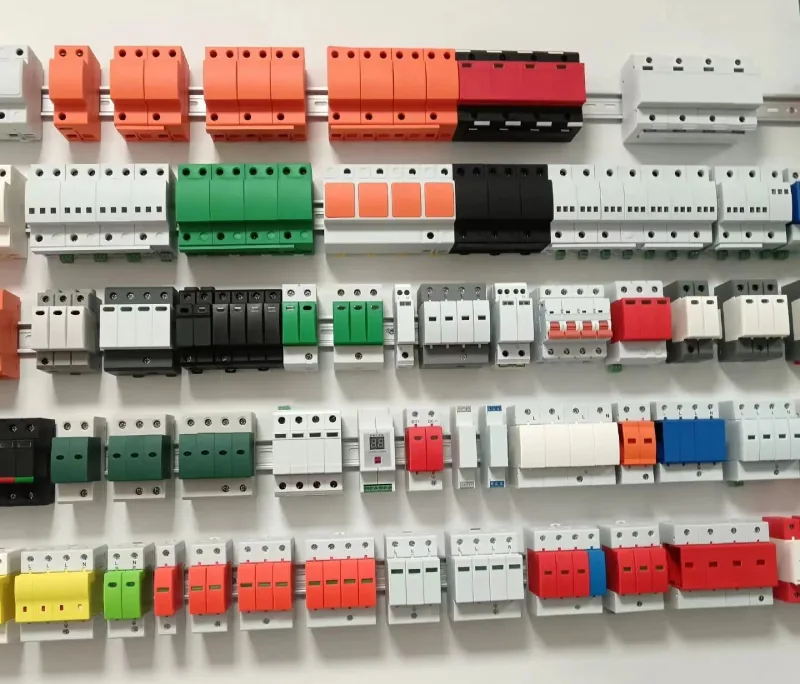တဲ့ ရေလှိုင်းကာကွယ်ရေးကိရိယာ (SPD) စက်ပစ္စည်းများနှင့် လျှပ်စစ်စနစ်များမှ ကာကွယ်ပေးသော လျှပ်စစ်ဘေးကင်းရေး အစိတ်အပိုင်းတစ်ခုဖြစ်သည်။ ဗို့အားမြင့်တက်ခြင်း။ လျှပ်စီးကြောင်းများ၊ ပါဝါလိုင်းပြောင်းခြင်း သို့မဟုတ် လျှပ်စစ်ချို့ယွင်းမှုများကြောင့်ဖြစ်သည်။ SPD များသည် ပိုလျှံနေသော လျှပ်စစ်စွမ်းအင်ကို မြေပြင်သို့ အလိုအလျောက်ပြောင်းပေးကာ ထိခိုက်လွယ်သော အီလက်ထရွန်နစ်ပစ္စည်းများ၊ ကရိယာများနှင့် လျှပ်စစ်အခြေခံအဆောက်အအုံများ ပျက်စီးဆုံးရှုံးမှုများကို ကာကွယ်ပေးပါသည်။
ရေလှိုင်းကာကွယ်ရေးကိရိယာများကို နားလည်ခြင်းသည် သင်၏လျှပ်စစ်ရင်းနှီးမြုပ်နှံမှုများကိုကာကွယ်ရန်၊ ကုဒ်လိုက်နာမှုသေချာစေရန်နှင့် လူနေအိမ်၊ စီးပွားရေးနှင့် စက်မှုလုပ်ငန်းသုံးအပလီကေးရှင်းများတွင် လျှပ်စစ်အန္တရာယ်ကို ထိန်းသိမ်းထားရန် အရေးကြီးပါသည်။
Surge Protection Device ဆိုတာ ဘာလဲ- နည်းပညာဆိုင်ရာ အဓိပ္ပါယ်ဖွင့်ဆိုချက်
Surge Protection device (SPD)၊ surge protective device သို့မဟုတ် transient voltage surge suppressor (TVSS) သည် လျှပ်စစ်ဆားကစ်များနှင့် ချိတ်ဆက်ထားသော စက်ပစ္စည်းများအား ဗို့အားလျှပ်စီးကြောင်းများနှင့် လှိုင်းတက်ခြင်းများမှ ကာကွယ်ရန် ဒီဇိုင်းထုတ်ထားသည့် လျှပ်စစ်အစိတ်အပိုင်းတစ်ခုဖြစ်သည်။
အဓိက နည်းပညာပိုင်းဆိုင်ရာ လက္ခဏာများ-
- Clamping ဗို့အား- SPD စတင်လုပ်ဆောင်သည့် ဗို့အားအဆင့်
- အမြင့်ဆုံး ဆက်တိုက် လည်ပတ်နေသော ဗို့အား (MCOV)- အမြင့်ဆုံး RMS ဗို့အား ကိရိယာသည် အဆက်မပြတ် ကိုင်တွယ်နိုင်သည်။
- လက်ရှိအဆင့်သတ်မှတ်ချက်ကို မြှင့်တင်ပါ။− အများဆုံးလက်ရှိ ကိရိယာသည် ဘေးကင်းစွာ လမ်းကြောင်းပြောင်းနိုင်သည် (ကီလိုဂရမ်ဖြင့် တိုင်းတာသည်)
- တုံ့ပြန်ချိန်: စက်ပစ္စည်းသည် ဗို့အားတက်ခြင်းအား မည်မျှလျင်မြန်စွာ တုံ့ပြန်သည် (ပုံမှန်အားဖြင့် နာနိုစက္ကန့်မှ မိုက်ခရိုစက္ကန့်များ)
Surge Protection Devices အမျိုးအစားများ- ပြီးပြည့်စုံသော အမျိုးအစားခွဲခြင်း။
တပ်ဆင်တည်နေရာအားဖြင့် SPD အမျိုးအစားခွဲခြားမှုများ
| SPD အမျိုးအစား | တပ်ဆင်ခြင်းတည်နေရာ | ကာကွယ်မှုအဆင့် | ပံုမွန္အသံုးခ်ျခင္း |
|---|---|---|---|
| အမျိုးအစား 1 (Class B) | မီတာနှင့် ပင်မဘောင်ကြားရှိ ဝန်ဆောင်မှုဝင်ပေါက် | တိုက်ရိုက်မိုးကြိုးပစ်ခြင်းမှ အဓိကကာကွယ်မှု | ပင်မလျှပ်စစ်ပြားများ၊ ပြင်ပတပ်ဆင်မှုများ |
| အမျိုးအစား 2 (Class C) | ပင်မလျှပ်စစ်ဘောင်၊ ဘောင်များ | အရှိန်အဟုန်မြင့်ခြင်းမှ ဆင့်ပွားကာကွယ်မှု | ဖြန့်ဝေမှုအကန့်များ၊ ဌာနခွဲဆားကစ်များ |
| အမျိုးအစား 3 (Class D) | အသုံးပြုရန်အချက်၊ တစ်ဦးချင်းဆိုင်များ | ထိခိုက်လွယ်သော ပစ္စည်းများအတွက် နောက်ဆုံးကာကွယ်မှု | အီလက်ထရွန်းနစ်ပစ္စည်းများ၊ ကွန်ပျူတာများ၊ ကိရိယာများ |
နည်းပညာအားဖြင့် SPD အမျိုးအစားခွဲခြားခြင်း
သတ္တုအောက်ဆိုဒ် Varistor (MOV) SPDs-
- အသုံးအများဆုံးလူနေအိမ်နှင့်စီးပွားရေးအမျိုးအစား
- မြန်ဆန်သောတုံ့ပြန်မှုအချိန်များ (နာနိုစက္ကန့်များ)
- ကိုယ်ကျိုးစွန့်နည်းပညာ
- အပလီကေးရှင်းအများစုအတွက် ကုန်ကျစရိတ်သက်သာသည်။
Gas Discharge Tube (GDT) SPDs-
- မြင့်မားသော surge current စွမ်းရည်
- တုံ့ပြန်မှုအကြိမ်ရေ နှေးကွေးခြင်း။
- သက်တမ်းပိုရှည်တယ်။
- တယ်လီဖုန်း ဆက်သွယ်ရေး အက်ပ်များအတွက် စံပြ
Silicon Avalanche Diode (SAD) SPDs-
- အမြန်ဆုံးတုံ့ပြန်မှုအချိန်
- တိကျသော ကုပ်လျှပ်စီးကြောင်းများ
- ကုန်ကျစရိတ်ပိုများသည်။
- ထိလွယ်ရှလွယ် အီလက်ထရွန်နစ် ပစ္စည်းများအတွက် အကောင်းဆုံး
Surge Protection Devices ဘယ်လိုအလုပ်လုပ်လဲ။
SPD များသည် အခြေခံမူ သုံးခုပေါ်တွင် လုပ်ဆောင်သည်-
- ဗို့အားစောင့်ကြည့်ရေး: ကိရိယာသည် ကာကွယ်ထားသောပေါ်ရှိ လျှပ်စစ်ဗို့အားကို စဉ်ဆက်မပြတ် စောင့်ကြည့်သည်။ တိုက်နယ်.
- Surge Detection: ဗို့အားသည် ကိရိယာ၏ ကုပ်တွယ်မှု သတ်မှတ်ချက်ထက် ကျော်လွန်သောအခါ၊ အတွင်းပိုင်း အစိတ်အပိုင်းများသည် အသက်ဝင်ပါသည်။
- စွမ်းအင်လွှဲခြင်း။: ပိုလျှံလျှပ်စစ်စွမ်းအင်ကို ရေအောက်မှ စက်ပစ္စည်းများကို ကာကွယ်ပေးသည့် မြေပြင်စနစ်သို့ လုံခြုံစွာ ကူးပြောင်းသည်။
အဆင့်ဆင့် Surge Protection လုပ်ငန်းစဉ်
- ပုံမှန်လည်ပတ်မှု: SPD သည် မြင့်မားသော impedance အခြေအနေတွင် ရှိနေပြီး ပုံမှန်စီးဆင်းမှုကို ခွင့်ပြုသည်။
- ရေလှိုင်းပွဲ: မိုးကြိုးပစ်ခြင်း သို့မဟုတ် လျှပ်စစ်ပြတ်တောက်မှုကြောင့် ဗို့အားတက်စေသည်။
- အသက်သွင်းခြင်း။: SPD သည် ဗို့အားလွန်နေသည့်အခြေအနေကို ထောက်လှမ်းပြီး နိမ့်သော impedance အခြေအနေသို့ ပြောင်းသည်။
- စွမ်းအင်လွှဲခြင်း။: ကာကွယ်ထားသော စက်များအစား SPD မှတဆင့် မြေပြင်သို့ လျှပ်စီးကြောင်း စီးဆင်းသည်။
- ပြန်လည်သတ်မှတ်ပါ။: SPD သည် လှိုင်းဖြတ်ပြီးနောက် မြင့်မားသော impedance အခြေအနေသို့ ပြန်သွားပါသည်။
SPD အက်ပ်များနှင့် အသုံးပြုမှုကိစ္စများ
လူနေထိုင်မှုလျှောက်လွှာများ
တစ်အိမ်လုံးကာကွယ်မှု-
- ပင်မလျှပ်စစ် panel တပ်ဆင်ခြင်း (Type 2 SPD)
- ဆားကစ်များနှင့် ချိတ်ဆက်ထားသော စက်အားလုံးကို ကာကွယ်ပေးသည်။
- ဒေသဆိုင်ရာလျှပ်စစ်ကုဒ်များစွာဖြင့် လိုအပ်သည်။
- ပုံမှန်လှိုင်းအဆင့်သတ်မှတ်ချက်- မုဒ်တစ်ခုလျှင် 40-80 kA
အသုံးပြုမှုကာကွယ်မှု-
- ထိခိုက်လွယ်သော အီလက်ထရွန်းနစ်ပစ္စည်းများအတွက် တစ်ဦးချင်းထွက်ပေါက်ကို အကာအကွယ်ပေးသည်။
- ကွန်ပျူတာ အလုပ်ရုံများနှင့် အိမ်တွင်းရုပ်ရှင်ရုံများ
- ဆေးပစ္စည်းနှင့် လုံခြုံရေးစနစ်များ
- ပုံမှန်ရေလှိုင်းအဆင့်သတ်မှတ်ချက်- 1-15 kA
ကုန်သွယ်လုပ်ငန်းခွန်နှင့်စက်မှုကေးရှင်း
အရေးကြီးသော အခြေခံအဆောက်အဦ ကာကွယ်ရေး-
- ဒေတာစင်တာများနှင့် ဆာဗာခြံများ
- ကုန်ထုတ်ပစ္စည်းကိရိယာများနှင့် ထိန်းချုပ်မှုများ
- ဆက်သွယ်ရေး တပ်ဆင်မှုများ
- အရေးပေါ်ဓာတ်အားစနစ်များ
အထူးစက်မှုလုပ်ငန်းလိုအပ်ချက်များ-
- ကျန်းမာရေးစောင့်ရှောက်မှု အထောက်အကူပစ္စည်းများ- ဆေးဘက်ဆိုင်ရာ ပစ္စည်းကာကွယ်ရေး
- ငွေရေးကြေးရေးအဖွဲ့အစည်းများ- ဒေတာခိုင်မာမှုကို အကာအကွယ်ပေးခြင်း
- ထုတ်လုပ်ခြင်း- လုပ်ငန်းစဉ်ထိန်းချုပ်မှုစနစ် အကာအကွယ်
- ဆက်သွယ်ရေး- ကွန်ရက်စက်ပစ္စည်းများကို အကာအကွယ်ပေးခြင်း
SPD ရွေးချယ်မှု စံသတ်မှတ်ချက်- ကျွမ်းကျင်သူ ဆုံးဖြတ်ချက် မူဘောင်
မရှိမဖြစ်ရွေးချယ်ရေးအချက်များ
- 1. ဗို့အားအဆင့်သတ်မှတ်ချက် လိုက်ဖက်နိုင်မှု
- SPD ဗို့အားအဆင့်သတ်မှတ်ချက်ကို စနစ်ဗို့အားနှင့် ယှဉ်ပါ။
- ဘုံအဆင့်သတ်မှတ်ချက်များ- 120V၊ 240V၊ 277V၊ 480V
- သင့်လျော်သော အဆင့်ဖွဲ့စည်းမှုကို သေချာစေပါ (အဆင့်တစ်ခုတည်း၊ အဆင့်သုံးဆင့်)
- 2. Surge Current Capacity
- မုဒ်တစ်ခုလျှင် 1: 25-100 kA အနည်းဆုံးရိုက်ပါ။
- အမျိုးအစား 2: လူနေအိမ်အတွက် 20-40 kA၊ လုပ်ငန်းသုံးအတွက် 40-160 kA
- အသုံးပြုသည့် အက်ပ်များအတွက် 3:1-15 kA ဟု ရိုက်ထည့်ပါ။
- 3. တုံ့ပြန်မှုအချိန်လိုအပ်ချက်များ
- အရေးပါသောအသုံးချပရိုဂရမ်များ- <1 နာနိုစက္ကန့်
- စံသတ်မှတ်ချက်များ- 1-25 နာနိုစက္ကန့်
- အခြေခံကာကွယ်မှု- 25+ နာနိုစက္ကန့်
SPD ရွေးချယ်မှုဇယား
| လျှောက်လွှာကိုအမျိုးအစား | SPD အမျိုးအစားကို အကြံပြုထားသည်။ | အနည်းဆုံး Surge Rating | အဓိကအင်္ဂါရပ်များ လိုအပ်ပါသည်။ |
|---|---|---|---|
| လူနေထိုင်ရာ ပင်မပန်နယ် | အမျိုးအစား 2, MOV နည်းပညာ | မုဒ်တစ်ခုလျှင် 40 kA | UL 1449 စာရင်း၊ အမြင်အာရုံညွှန်းကိန်းများ |
| ကူးသန်းရောင်းဝယ်ရေး | 2၊ MOV သို့မဟုတ် hybrid အမျိုးအစား | မုဒ်တစ်ခုလျှင် 80-160 kA | အဝေးထိန်းစနစ်၊ အစားထိုးနိုင်သော မော်ဂျူးများ |
| စက်မှုအရေးပါသော Loads များ | Type 1 + Type 2 ညှိနှိုင်းပါ။ | မုဒ်တစ်ခုလျှင် 100+ kA | မအောင်မြင်သောဒီဇိုင်း၊ အရန်ကာကွယ်မှု |
| လျှပ်စစ်ပစ္စည်းအသုံးပြုမှု | 3၊ SAD သို့မဟုတ် MOV ရိုက်ထည့်ပါ။ | 1-6 kA | အနိမ့်ကုပ်လျှပ်စီးကြောင်း၊ EMI စစ်ထုတ်ခြင်း။ |
တပ်ဆင်မှုလိုအပ်ချက်များနှင့် ကုဒ်လိုက်နာမှု
အမျိုးသားလျှပ်စစ်ကုဒ် (NEC) လိုအပ်ချက်များ
⚠️ ဘေးကင်းရေးသတိပေးချက်- SPD တပ်ဆင်ခြင်းကို အရည်အချင်းပြည့်မီသော လျှပ်စစ်ပညာရှင်များမှ လုပ်ဆောင်ပြီး ဒေသဆိုင်ရာ အာဏာပိုင်များမှ စစ်ဆေးရပါမည်။
အပိုဒ် 285 – Surge Protective Devices (SPDs)-
- အဆင့်သတ်မှတ်ထားသော SPD များသည် 1000V သို့မဟုတ် ထို့ထက်နည်းသော စက်ပစ္စည်းများကို စာရင်းပြုစုထားရပါမည်။
- တပ်ဆင်ခြင်းသည် ထုတ်လုပ်သူ၏ သတ်မှတ်ချက်များအတိုင်း လုပ်ဆောင်ရပါမည်။
- မှန်ကန်သော မြေပြင်နှင့် ချည်နှောင်မှု လိုအပ်ပါသည်။
- အဆက်ဖြတ်ခြင်းဆိုသည်မှာ လိုအပ်နိုင်ပါသည်။
တပ်ဆင်ခကောင်းဆုံးအလေ့အကျင့်
- သင့်လျော်သောမြေပြင်
- အတိုဆုံးလက်တွေ့ကျသော စပယ်ယာအရှည်များကို အသုံးပြုပါ (အကောင်းဆုံးအားဖြင့် <12 လက်မ)
- grounding conductors များတွင် ချွန်ထက်သောကွေးညွှတ်ခြင်းကို ရှောင်ကြဉ်ပါ။
- စက်ပစ္စည်းများကို grounding conductor နှင့် ခိုင်ခံ့သော ချိတ်ဆက်မှုများကို သေချာပါစေ။
- Type 1 SPDs အတွက် သီးသန့်မြေပေါ်လျှပ်ကူးပစ္စည်းကို စဉ်းစားပါ။
- SPD အမျိုးအစားများအကြား ပူးပေါင်းဆောင်ရွက်ခြင်း
- လိုအပ်သည့်အခါ ဝန်ဆောင်မှုဝင်ပေါက်တွင် Type 1 ကို ထည့်သွင်းပါ။
- ဖြန့်ဖြူးမှုအကန့်များတွင် အမျိုးအစား 2 SPD များကို ထားရှိပါ။
- ထိလွယ်ရှလွယ် ကိရိယာများကို ကာကွယ်ရန်အတွက် Type 3 SPDs ကို အသုံးပြုပါ။
- သင့်လျော်သော လျှပ်စစ်အကွာအဝေးကို ထိန်းသိမ်းပါ။
- စောင့်ကြည့်ထိန်းသိမ်းခြင်း။
- အမြင်အာရုံအခြေအနေ အညွှန်းများဖြင့် SPDs ကို ထည့်သွင်းပါ။
- အရေးကြီးသော အပလီကေးရှင်းများအတွက် အဝေးထိန်းစောင့်ကြည့်ခြင်းကို စဉ်းစားပါ။
- ပုံမှန်စစ်ဆေးရေးအချိန်ဇယားကို ချမှတ်ပါ။
- မအောင်မြင်သော သို့မဟုတ် ပျက်စီးသွားသော စက်များကို ချက်ချင်း အစားထိုးပါ။
အမြင့်ဆုံးကာကွယ်မှုအတွက် ကျွမ်းကျင်သူ အကြံပြုချက်များ
💡 ကျွမ်းကျင်သော အကြံပြုချက်- စက်ပစ္စည်းတစ်ခုချင်းမဟုတ်ဘဲ ညှိနှိုင်းစနစ်တစ်ခုအဖြစ် အကောင်အထည်ဖော်သည့်အခါတွင် ရေလှိုင်းကာကွယ်ရေးသည် အထိရောက်ဆုံးဖြစ်သည်။
အဆင့်မြင့်ကာကွယ်ရေးဗျူဟာများ-
- ကာကွယ်မှုအဆင့်များစွာကို အသုံးပြုပါ (အမျိုးအစား 1၊ 2၊ နှင့် 3 ပေါင်းစပ်ညှိနှိုင်းမှု)
- ကာကွယ်ထားသော ပစ္စည်းများနှင့် တတ်နိုင်သမျှ နီးစပ်အောင် SPD များကို တပ်ဆင်ပါ။
- ထိလွယ်ရှလွယ် အီလက်ထရွန်းနစ်ပစ္စည်းများအတွက် EMI/RFI စစ်ထုတ်ခြင်းကို ထည့်သွင်းစဉ်းစားပါ။
- သင့်လျော်သော လျှပ်စစ်အထီးကျန်နည်းပညာများကို အကောင်အထည်ဖော်ပါ။
ရှောင်ရှားရန် အဖြစ်များသော တပ်ဆင်မှု အမှားများ
- အလွန်အကျွံ conductor အရှည်များသည်ထိရောက်မှုကိုလျှော့ချ
- မြေပြင်စနစ်ချိတ်ဆက်မှု မလုံလောက်ခြင်း။
- သဟဇာတမဖြစ်သော SPD နည်းပညာများကို ရောစပ်ခြင်း။
- ထုတ်လုပ်သူ အကွာအဝေး သတ်မှတ်ချက်များကို လျစ်လျူရှုခြင်း။
ပြဿနာဖြေရှင်းခြင်းနှင့် ပြုပြင်ထိန်းသိမ်းခြင်း။
SPD အခြေအနေကို စောင့်ကြည့်လေ့လာခြင်း။
အမြင်အာရုံညွှန်းကိန်းများ-
- အစိမ်းရောင် LED- စက်ပစ္စည်းကို လည်ပတ်စေပြီး ကာကွယ်ပေးသည်။
- အနီရောင် LED- စက်ပစ္စည်းသည် အခိုးခံရသည် သို့မဟုတ် မအောင်မြင်ပါ။
- LED မရှိပါ- ပါဝါထောက်ပံ့မှုကို စစ်ဆေးပါ သို့မဟုတ် စက်ပစ္စည်းကို အစားထိုးပါ။
စွမ်းဆောင်ရည် စမ်းသပ်ခြင်း-
- နှစ်စဉ် insulation resistance စမ်းသပ်ခြင်း။
- ချိတ်ဆက်မှုများနှင့် အညွှန်းများကို ကြည့်ရှုစစ်ဆေးခြင်း။
- သင့်လျော်သော မြေပြင်အဆက်ပြတ်မှုကို အတည်ပြုခြင်း။
- ကုဒ်လိုက်နာမှုအတွက် စစ်ဆေးမှုရလဒ်များကို မှတ်တမ်းပြုစုခြင်း။
SPDs တွေကို ဘယ်အချိန်မှာ အစားထိုးမလဲ။
အစားထိုး အညွှန်းများ-
- မအောင်မြင်သော အခြေအနေညွှန်ပြချက်
- ရုပ်ပိုင်းဆိုင်ရာ ထိခိုက်မှု သို့မဟုတ် အပူလွန်ကဲခြင်း လက္ခဏာများ
- ထူးထူးခြားခြား ရေလှိုင်းကြီးပြီးရင်
- ထုတ်လုပ်သူ အကြံပြုထားသော ဝန်ဆောင်မှုသက်တမ်း ကျော်လွန်သွားပါသည်။
အမြန်ကိုးကား- SPD ရွေးချယ်မှုလမ်းညွှန်
လူနေအမြန်ရွေးချယ်ရေး
| အကာအကွယ်လိုအပ်ခြင်း။ | SPD အမျိုးအစား | တပ်ဆင်ခြင်းတည်နေရာ | ရိုးရိုးအဆင့်သတ်မှတ်ခြင်း။ |
|---|---|---|---|
| တစ်အိမ်လုံး | 2 MOV ရိုက်ပါ။ | ပင်မလျှပ်စစ်ဘောင် | 40-80 kA |
| လျှပ်စစ်ပစ္စည်း | 3 MOV/SAD ရိုက်ထည့်ပါ။ | တစ်ဦးချင်းဆိုင်များ | 1-6 kA |
| HVAC စက်ပစ္စည်း | 2 MOV ရိုက်ပါ။ | စက်ပစ္စည်းအဆက်ဖြတ်ပါ။ | 20-40 kA |
ကူးသန်းရောင်းဝယ်ရေး အမြန်ရွေးချယ်မှု
| Facility အမျိုးအစား | မူလတန်းကာကွယ်စောင့်ရှောက်ရေး | အလယ်တန်းကာကွယ်ရေး | ပွိုင့်-အသုံးပြုမှု |
|---|---|---|---|
| ရုံးအဆောက်အဦ | 2, 80 kA အမျိုးအစား | 2, 40 kA အမျိုးအစား | 3, 6 kA အမျိုးအစား |
| ဒေတာစင်တာ | 1, 100 kA အမျိုးအစား | 2, 160 kA အမျိုးအစား | 3, 1 kA အမျိုးအစား |
| ကုန်ထုတ်လုပ်ငန်း | 1, 160 kA အမျိုးအစား | 2, 80 kA အမျိုးအစား | 3, 15 kA အမျိုးအစား |
မကြာခဏမေးမေးခွန်းများ
လျှပ်စီးကြောင်း ကာကွယ်ရေး ကိရိယာကို ပါဝါကြိုးနှင့် မတူအောင် ဘာက ပြုလုပ်သနည်း။
စစ်မှန်သော SPD ကို UL 1449 အသိအမှတ်ပြုလက်မှတ်၊ သင့်လျော်သော ကုပ်လျှပ်စီးကြောင်းများနှင့် လုံလောက်သော လှိုင်းလျှပ်စီးကြောင်းစွမ်းရည်တို့နှင့်အတူ ရေလှိုင်းကာကွယ်ရေးအတွက် အထူးဒီဇိုင်းဆွဲပြီး စမ်းသပ်ထားသည်။ အခြေခံပါဝါကြိုးများသည် မကြာခဏဆိုသလို အနည်းငယ်မျှသာ သို့မဟုတ် အမှန်တကယ် လျှပ်စီးကြောင်းကို အကာအကွယ်ပေးပါသည်။
ကျွန်ုပ်၏ SPD အလုပ်လုပ်ပုံ ကောင်းမွန်ခြင်း ရှိ၊ မရှိ မည်သို့ သိနိုင်မည်နည်း။
အရည်အသွေး SPD အများစုတွင် လုပ်ငန်းလည်ပတ်မှုအခြေအနေကိုပြသသော ရုပ်ထွက်အခြေအနေအညွှန်းများ (LED မီးများ) ပါဝင်သည်။ အစိမ်းရောင်သည် ပုံမှန်အားဖြင့် ကာကွယ်ခြင်းဟု အဓိပ္ပါယ်ရပြီး အနီရောင်သည် အစားထိုးခြင်းကို ဆိုလိုသည်။ ညွှန်ပြချက်မရှိပါက၊ ကိရိယာအား အရည်အချင်းပြည့်မီသော လျှပ်စစ်ပညာရှင်မှ စမ်းသပ်သင့်သည်။
ကျွန်ုပ်ကိုယ်တိုင် SPD ကို ထည့်သွင်းနိုင်ပါသလား။
Type 3 point-of-use SPDs များကို ပုံမှန်အားဖြင့် အိမ်ပိုင်ရှင်များက တပ်ဆင်နိုင်သော်လည်း Type 1 နှင့် Type 2 စက်ပစ္စည်းများသည် လျှပ်စစ်ကုဒ်လိုအပ်ချက်များနှင့် ဘေးကင်းရေးဆိုင်ရာ ထည့်သွင်းစဉ်းစားမှုများကြောင့် လိုင်စင်ရ လျှပ်စစ်ပညာရှင်များမှ တပ်ဆင်ရန် လိုအပ်ပါသည်။
ကျွန်ုပ်၏အိမ်အတွက် SPD အရွယ်အစားမည်မျှလိုအပ်သနည်း။
တစ်အိမ်လုံး အကာအကွယ်အတွက်၊ 40-80 kA surge current rating ပါသော Type 2 SPD သည် ပုံမှန်အားဖြင့် လူနေထိုင်ရန် အတွက် လုံလောက်ပါသည်။ သင့်လျှပ်စစ်စနစ်အပေါ်အခြေခံ၍ တိကျသောအကြံပြုချက်များအတွက် အရည်အချင်းပြည့်မီသော လျှပ်စစ်ပညာရှင်နှင့် တိုင်ပင်ပါ။
SPDs များ တက်လာပြီးနောက် အစားထိုးရန် လိုအပ်ပါသလား။
သေချာပေါက်။ အရည်အသွေးပြည့် SPDs များသည် များပြားလှသော ရေလှိုင်းဖြစ်ရပ်များကို ကိုင်တွယ်ရန် ဒီဇိုင်းထုတ်ထားသည်။ သို့သော်၊ သင်သည် အခြေအနေ အညွှန်းများကို စစ်ဆေးသင့်ပြီး အနီးနားရှိ မိုးကြိုးပစ်ခြင်းကဲ့သို့ သိသာထင်ရှားသော လျှပ်စစ်ဆိုင်ရာ ဖြစ်ရပ်တစ်ခုခုပြီးနောက် စက်ပစ္စည်းကို စစ်ဆေးသင့်သည်။
Surge Protection ကိရိယာများသည် မည်မျှကြာကြာခံနိုင်မည်နည်း။
ပုံမှန် SPD ဝန်ဆောင်မှုသက်တမ်းသည် နည်းပညာ၊ ပတ်ဝန်းကျင်အခြေအနေနှင့် ရေလှိုင်းလှုပ်ရှားမှုပေါ်မူတည်၍ 5 နှစ်မှ 10 နှစ်အထိဖြစ်သည်။ မအောင်မြင်သော ညွှန်ကိန်းများကို ပုံမှန်စောင့်ကြည့်ခြင်းနှင့် အစားထိုးခြင်းသည် ဆက်လက်ကာကွယ်မှုကို သေချာစေသည်။
SPD တပ်ဆင်ခြင်းအတွက် မည်သည့်လျှပ်စစ်ကုဒ်များ သက်ရောက်သနည်း။
အမျိုးသားလျှပ်စစ်ဥပဒေ (NEC) ပုဒ်မ ၂၈၅ သည် အမေရိကန်ပြည်ထောင်စုတွင် SPD တပ်ဆင်မှုများကို အုပ်ချုပ်သည်။ ဒေသတွင်းကုဒ်များတွင် နောက်ထပ်လိုအပ်ချက်များ ရှိနိုင်သည်။ ဒေသဆိုင်ရာလျှပ်စစ်အာဏာပိုင်များနှင့် လက်ရှိကုဒ်လိုအပ်ချက်များကို အမြဲတမ်းစစ်ဆေးပါ။
Type 1၊ Type 2 သို့မဟုတ် Type 3 SPDs ကို သုံးသင့်ပါသလား။
၎င်းသည် သင်၏ သီးခြားအပလီကေးရှင်းနှင့် ဒေသတွင်းကုဒ်လိုအပ်ချက်များအပေါ် မူတည်သည်။ အမျိုးအစား 1 သည် တိုက်ရိုက်လျှပ်စီးကြောင်းမှကာကွယ်ရန် ဝန်ဆောင်မှုဝင်ပေါက်အတွက်၊ ဖြန့်ဖြူးမှုအကန့်ကာကွယ်မှုအတွက် အမျိုးအစား 2 နှင့် အသုံးပြုမှုမှကာကွယ်မှုအတွက် အမျိုးအစား 3 ဖြစ်သည်။ အပလီကေးရှင်းများစွာသည် ပေါင်းစပ်ထားသော အဆင့်များစွာသော အကာအကွယ်မှ အကျိုးခံစားခွင့်ရှိသည်။
ပရော်ဖက်ရှင်နယ်အကြံပြုချက်များ
လိုင်စင်ရ လျှပ်စစ်ပညာရှင်ကို ဘယ်အချိန်မှာ တိုင်ပင်ရမလဲ။
- ပင်မဘောင် သို့မဟုတ် ဖြန့်ဖြူးမှုအကန့် SPD တပ်ဆင်ခြင်း။
- သင့်လျော်သော SPD အရွယ်အစားကို ဆုံးဖြတ်ခြင်းနှင့် ညှိနှိုင်းဆောင်ရွက်ခြင်း
- ရေလှိုင်းကာကွယ်ရေး လိုအပ်ချက်များ အတွက် လျှပ်စစ်စနစ် အကဲဖြတ်ခြင်း။
- ကုဒ်လိုက်နာမှုအတည်ပြုခြင်းနှင့် စစ်ဆေးရေးပြင်ဆင်ခြင်း။
အောင်လက်မှတ်နှင့် လေ့ကျင့်ရေးလိုအပ်ချက်များ-
- လျှပ်စစ်ဝန်ထမ်းများသည် သင့်လျော်သော နိုင်ငံတော်လိုင်စင်ကို ကိုင်ဆောင်ထားရမည်။
- SPD ထုတ်လုပ်သူများသည် အထူးပြုသင်တန်းများ ပေးလေ့ရှိသည်။
- အရေးကြီးသောအပလီကေးရှင်းများအတွက် အသိအမှတ်ပြုထားသော လျှပ်စီးကြောင်းကာကွယ်ရေးကျွမ်းကျင်သူများကို စဉ်းစားပါ။
- ပြောင်းလဲလာသော ကုဒ်လိုအပ်ချက်များနှင့် ပတ်သက်၍ ပုံမှန်ဆက်လက်သင်ကြားခြင်း။
ရေလှိုင်းကာကွယ်ရေးကိရိယာများသည် ခေတ်မီလျှပ်စစ်ဘေးကင်းရေးစနစ်များ၏ မရှိမဖြစ် အစိတ်အပိုင်းများဖြစ်သည်။ မှန်ကန်သောရွေးချယ်မှု၊ တပ်ဆင်မှုနှင့် ပြုပြင်ထိန်းသိမ်းမှုတို့သည် ကုဒ်လိုက်နာမှုလိုအပ်ချက်များနှင့်ကိုက်ညီနေချိန်တွင် သင့်လျှပ်စစ်ရင်းနှီးမြုပ်နှံမှုအတွက် ယုံကြည်စိတ်ချရသောအကာအကွယ်ကိုသေချာစေသည်။ ရှုပ်ထွေးသောအပလီကေးရှင်းများ သို့မဟုတ် အရေးပါသောစနစ်များအတွက်၊ ပြည့်စုံသောရေလှိုင်းကာကွယ်ရေးဗျူဟာများကို ရေးဆွဲရန်နှင့် အကောင်အထည်ဖော်ရန် အရည်အချင်းပြည့်မီသော လျှပ်စစ်ကျွမ်းကျင်ပညာရှင်များနှင့် အမြဲတိုင်ပင်ပါ။
ဆက်စပ်
မင်းရဲ့ ဆိုလာစွမ်းအင်စနစ်အတွက် မှန်ကန်တဲ့ SPD ကို ဘယ်လိုရွေးချယ်မလဲ။





